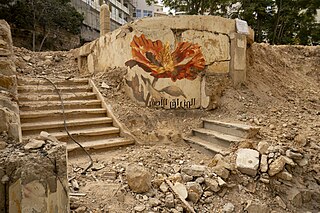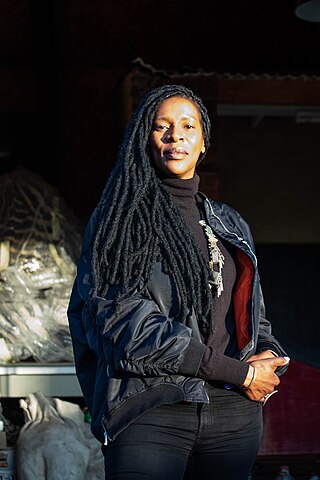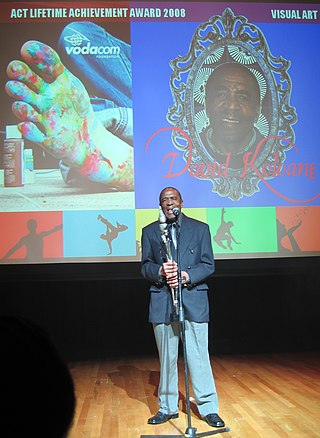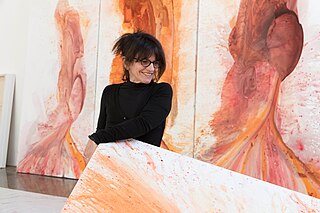Related Research Articles
Jeremy Wafer is a South African sculptor and printmaker.

Judith Mason born Judith Seelander Menge was a South African artist who worked in oil, pencil, printmaking and mixed media. Her work is rich in symbolism and mythology, displaying a rare technical virtuosity.

Joburg Art Fair is a contemporary art fair held annually in Johannesburg, South Africa. The first show took place from 13 to 16 March 2008. The second Joburg Art Fair is scheduled for 3 April to 5 April 2009.
Matthew Hindley is a South African painter. He graduated from the Michaelis School of Fine Art, Cape Town in 2002, where he was awarded the Michaelis Prize.

Diane Victor, is a South African artist and print maker, known for her satirical and social commentary of contemporary South African politics.

Faith47 / Faith XLVII is a South African interdisciplinary artist. Her inaugeral museum exhibition CLAIR OBSUR took place at the Musee Des Beaux Arts de Nancy (2023). She has held solo exhibitions in Paris (2023), Cape Town (2021), Miami (2018), New York City (2015), London (2014) and Johannesburg (2012).

Nandipha Mntambo is a South African artist who has become famous for her sculptures, videos and photographs that focus on human female body and identity by using natural, organic materials. Her art style has been self described as eclectic and androgynous. She is best known for her cowhide sculptures that connects the human form to nature.

David Nthubu Koloane was a South African artist. In his drawings, paintings and collages he explored questions about political injustice and human rights. Koloane is considered to have been "an influential artist and writer of the apartheid years" in South Africa.
Tom Cullberg is an artist born in Stockholm, Sweden, in 1972. He currently lives and works in Cape Town, South Africa.
Jacki McInnes is a South African artist living and working in Johannesburg. Her art tends towards a style of binary interrogation: migrancy versus xenophobia, material aspirations versus poverty, the survival strategies of newly urbanised populations, and the complexities associated with the lived realities of late-capitalism. Current work, in particular, explores the contradictions inherent in present-day human thought and behaviour, especially regarding the disconnect between material aspiration, rampant consumerism, wasteful practices, and their disastrous effect on our planet and ultimate future.
Cedric Nunn is a South African photographer best known for his photography depicting the country before and after the end of apartheid.
Nontsikelelo "Lolo" Veleko is a South African photographer most noted for her depiction of black identity, urbanisation and fashion in post-apartheid South Africa.
Mary Sibande is a South African artist based in Johannesburg. Her art consists of sculptures, paintings, photography, and design. Sibande uses these mediums and techniques to help depict the human form and explore the construction of identity in a postcolonial South African context. In addition, Sibande focuses on using her work to show her personal experiences while living through Apartheid. Her art also attempts to critique stereotypical depictions of women, particularly black women.

Penny Siopis is a South African artist from Cape Town. She was born in Vryburg in the North West province from Greek parents who had moved after inheriting a bakery from Siopis maternal grandfather. Siopis studied Fine Arts at Rhodes University in Makhanda, completing her master's degree in 1976, after which she pursued postgraduate studies at Portsmouth Polytechnic in the United Kingdom. She taught Fine Arts at the Technikon Natal in Durban from 1980 to 1983. In 1984 she took up a lectureship at the University of the Witwatersrand in Johannesburg. During this time she was also visiting research fellow at the University of Leeds (1992–93) and visiting professor in fine arts at Umeå University in Sweden (2000) as part of an interinstitutional exchange. With an honorary doctorate from Rhodes University, Makhanda – Siopis is currently honorary professor at Michaelis School of Fine Art, University of Cape Town.
Lionel Smit is a South African artist, known for his contemporary portraiture executed through large canvases and sculptures.
Deborah Bell is a South African painter and sculptor whose works are known internationally.
Kagiso Patrick "Pat" Mautloa is a multi-media visual artist based in Johannesburg, South Africa.
Carl Walter Meyer was a South African artist born in Aliwal North, Eastern Cape. Meyer graduated from the University of Pretoria with a degree in Fine Art. He furthered his studies at the "Staatliche Kunstakademie” in Düsseldorf, Western Germany, under professor Michael Buthe. He was living in Upington, Northern Cape at the time of his death.
Ann Mary Gollifer is a British-Guyanese visual artist currently based in Gaborone, Botswana. Her work Mother Tongue can be seen on display in the Sainsbury African Galleries, a part of the British Museum's permanent collection.
Bongiwe or Bongi Dhlomo-Mautloa, is a Zulu South African printmaker, arts administrator and activist.
References
- ↑ de Kock, Yolanda (27 March 2019). "Helen Sebidi: #5WomenArtists Campaign" . Retrieved 19 April 2019.
- ↑ Festival, National Arts. "Full list of Standard Bank Young Artist Award winners". National Arts Festival. Retrieved 18 April 2019.
- ↑ Sichel, Adrienne (1 January 1989). "The 1989 Grahamstown Festival". South African Theatre Journal. 3 (2): 116–120. doi:10.1080/10137548.1989.9687982. ISSN 1013-7548.
- ↑ n.n. (19 October 2004). "Mapula Helen Sebidi (1943 - )". Archived from the original on 10 May 2019. Retrieved 19 April 2019.
- ↑ "Mmakgabo Helen Sebidi | Biography". www.everard-read-capetown.co.za. Retrieved 18 April 2019.
- ↑ Staff writer, Arts and Culture Trust (11 May 2011). "Helen Sebidi wins ACT Lifetime Achievement Award". Archived from the original on 19 April 2019. Retrieved 19 April 2019.
- ↑ Staff writer, Mbokodo Awards (14 September 2015). "Women in Indigenous Art" . Retrieved 19 April 2019.
- ↑ Mafika (15 September 2015). "South African women in arts honoured". Brand South Africa. Retrieved 18 April 2019.
- ↑ Malatjie, Portia (1 September 2018). "Batlhaping Ba Re!" . Retrieved 19 April 2019.
- ↑ Brown, Carol (1998). "The Zebra has lost its Stripes post-apartheid South African art". India International Centre Quarterly. 25 (1): 67–84. ISSN 0376-9771. JSTOR 23005605.
- ↑ Leeb-du Toit, Juliette (2009). Mmakgabo Mmapula Mmankgato Helen Sebidi. Johannesburg: David Krut. p. 60. ISBN 978-0-9814188-7-2.
- 1 2 3 4 5 6 7 Sosibo 2016.
- ↑ Peffer, John (2009). Art and the End of Apartheid. Minneapolis: University of Minnesota Press. p. 67. ISBN 978-0-8166-5001-9.
- ↑ Arnold, M. (1989). Helen Mmakgoba Mmapula Sebidi: Standard Bank Young Artist Award 1989. Johannesburg: Standard Bank. p. 7.
- ↑ Leeb-du Toit, Juliette (2009). Mmakgabo Mmapula Mmankagato Helen Sebidi. New York: David Krut Publishing. p. 35. ISBN 978-0-9814188-7-2.
- ↑ Björk, Christina; Danielsson, Kerstin; Serenander, Bengt; Kulturhuset (Stockholm, Sweden); Riksutställningar (Sweden); Sweden; Styrelsen för internationell utveckling (1990). Art/images in southern Africa: Stockholm, the Culture House, May 19-September 24, 1989 : touring Sweden and the Nordic countries until May 1990 = Bild/konst i södra Afrika : Stockholm, Kulturhuset, 19 maj-24 september 1989 : därefter turné i Sverige och Norden t.o.m. maj 1990. Stockholm: Kulturhuset : Riksutställningar. ISBN 9789186476212. OCLC 24980376.
- ↑ Court, Elsbeth (1992). "Pachipamwe II: The Avant Garde in Africa?". African Arts. 25 (1): 38–98. doi:10.2307/3337019. ISSN 0001-9933. JSTOR 3337019.
- ↑ "Art times" (PDF). arttimes.co.za. Retrieved 9 May 2019.
- ↑ Spier Contemporary 2010. Africa Centre http://www.spiercontemporary.co.za/artists-detail/helen-sebidi . Retrieved 7 September 2019.
{{cite web}}: Missing or empty|title=(help)